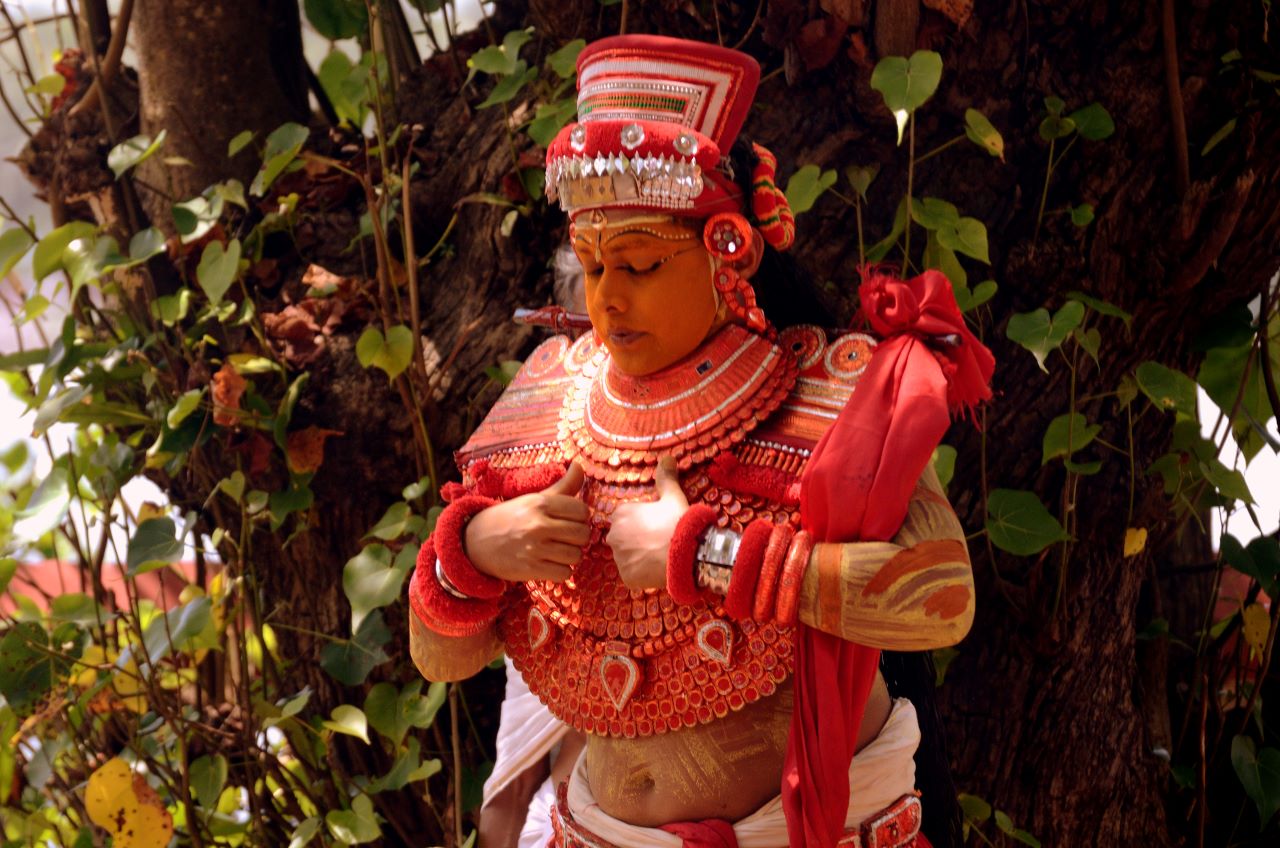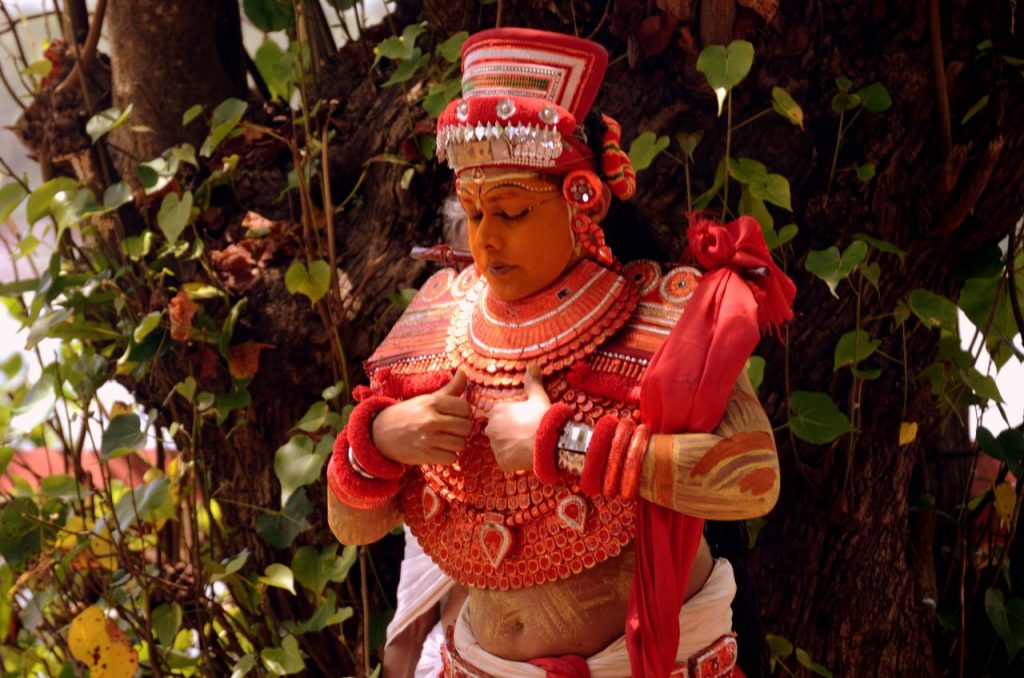
It began, as most of my travels do, with a fascinating conversation. Not from a guidebook or a brochure, but from an old woman in a spice shop in Kozhikode. She was measuring out peppercorns when she looked up, eyes gleaming. “Go where the stories are quiet,” she said, almost as if she were sharing a secret. “That’s where the gods still walk.”

Kerala unfolded like a slow song. One that began with the scent of rain and the rumbles of bamboo stalks as the gentle breeze brought in forgotten tales. It didn’t reveal itself all at once. It whispered in fragments of conversations. I discovered lost traditions, healing vibes and ancient warriors and custodians.
In Vadakara, I walked barefoot into the Kalari of Meenakshi Amma, the doyen of the martial arts, one of the foremost and first female Kallaripayattu practitioners to receive the prestigious Padma Shri a few years ago.
The earth beneath my feet felt sacred, packed with centuries of devotion, discipline, and sweat. The air vibrated with energy—sharp and silent—as young girls and boys swirled their wooden sticks, slicing the stillness and moving faster than shadows at sunset. The movements rooted in earth, air and fire, as the fierce elegance of Kalaraipayatu flowed like poetry in motion , a form of meditation in itself.
Amma didn’t speak much, but she didn’t need to. In her eighties now, her presence alone commanded reverence. A living legacy and a force to reckon with, she radiated a stillness that made the flurry of action around her seem choreographed by breath. Draped in a simple saree, she moved with the ease of someone who had become one with the space she inhabited. Her eyes scanned the room, missing nothing.
When she is in combat mode, she is formidable and fearless, agile and nimble-footed, but when she is with her little girls, who are her students, she is full of warmth and affection as she gently puts an arm around them, adjusting a fold in their costumes.” Kalaripayattu is a part of me and I am a part of it. It’s like breathing to me,” she says.
Kalaripayattu or Kalari is one of the oldest martial arts, dating to over 3000 years. The Goddess Bhagavathy is the patron deity of the martial art which is practiced all over the Malabar region of Kerala and is taught in the Guru Shishya Parampara.
Meenakshi Amma then adds, “Kalaripayattu makes us all become brave soldiers. For women, it’s not just about self-defense, but also about empowerment. Women become very confident and strong both physically and mentally. Every girl , woman, even housewives should learn. Even you should. “
The road pulled me to Sargaalaya, an arts and crafts village located in Iringal near Vadakara that literally translates to a home of creativity When we entered the portals of Sargaalaya from the dusty highway, I was literally blown away. An old quarry site had been revived and it had now morphed into a beautiful, placid lake. Birds roosting in the branches of trees called out in unison inviting me.
The campus was spread around 20 acres and it was an island with the River Moorad flowing behind. They even had a small guest house and from my room, I could see the vast expanse of the waters and the remnants of the rocks from the quarry creating a vivid picture.
Kerala murals, terracotta sculptures, paintings, traditional weaves, pottery, basket and cane weaving, temple arts and crafts – name it and every art and craft found an artist here. Everywhere there were artisans creating art in the open, their fingers stained with dye, their stories shaped in clay.
The campus was truly a home to over 45 women and 20 men who are artisans who were from neighbouring villages and were handpicked by Sargaalaya. Live demonstrations and workshops of several arts and crafts were performed by the artisans. In Sargaalaya, craft wasn’t a product. It was a living breathing creative story unfolding in every artisan’s hands
A potter invited me to try the wheel. “Clay remembers,” he said. “If you’re angry, it will resist you.” My hands trembled as I shaped a small bowl. It wobbled but held. “Not bad,” he smiled. “You’re listening.”
Healing in Kerala is about time. About stillness.
In a quiet ashram and not a fancy resort, I surrendered to Ayurveda. My Vaidyar looked into my eyes, held my wrist, and said: “You overthink too much. Let go. Live a little,” I nodded lost into the various aromas waltzing in the air . Steam. Oil. Leaves boiled into bitter concoctions. Sleep that arrived not like escape, but like a returning.
I wasn’t healed. Just tuned. I realized that In Kerala, you don’t find stories.
You wait long enough, and they find you.
Discovering little nuggets of stories can now be made possible by chatting with Maya, the Kerala Tourism chatbot, your friendly local guide, wise and knowledgeable like any fascinating local. Explore the Kerala of your dreams and experience personalised travel planning by planning your trip of the time through navigating Kerala Tourism
Please visit our sponsor:
Our Sponsor
